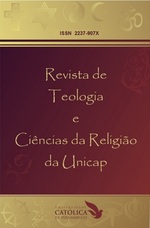A CONCEPÇÃO DE SÍMBOLO EM MIRCEA ELIADE E PAUL RICOEUR E A RELIGIÃO
DOI:
https://doi.org/10.25247/paralellus.2021.v12n31.p683-699Palavras-chave:
Símbolo, Hermenêutica, Religião, Fenômeno religiosoResumo
Este artigo tem por objetivo apresentar o conceito de símbolo, enquanto paradigma epistemológico de sistematização do pensamento, a partir de duas perspectivas: a de Mircea Eliade e a de Paul Ricoeur. Ambos, por diferentes perspectivas, tocam no que tange à religião. O historiador das religiões Eliade concebe o símbolo como ligado ao sagrado, marcado por uma dimensão ontológica, enquanto homo religiosus, a partir do homo significans que caracteriza o homo symbolicus. O símbolo, assim, é visto como fonte de sentido que prolonga a hierofania ou a substitui; revela uma realidade sagrada ou cosmológica não possibilitada por nenhuma outra “manifestação”. O filósofo francês Paul Ricoeur, por sua vez, concebe o símbolo a partir do seu duplo sentido: o sentido aparente e o oculto. Para ele, o símbolo implica uma análise da linguagem na qual a significância ligada intimamente ao símbolo está na interpretação, na articulação do linguístico e do não-linguístico, da linguagem e da experiência vivida. Em Ricoeur, o símbolo envolve a linguagem insubstituível do domínio da experiência, por ele chamada experiência da confissão. O símbolo é o ponto de partida de sua prática hermenêutica. Veremos, por um método analítico, que, enquanto o filósofo francês traz às claras a sua particularidade analítica em relação ao símbolo no predomínio da antropologia, o historiador das religiões concebe o homo religiosus aberto ao símbolo, sendo esse meio exercício de sua transcendência. Portanto, por caminhos diferentes, com a concepção de símbolo, ambos colaboram na compreensão da religião.
Downloads
Referências
ALLEN, Douglas. Myth and Religion in Mircea Eliade, New York: Routledge. 1998
CALINESCO, Matei. Imagination et sens. Attitudes 'esthétiques'. in: TACOU, C. (ed.) Mircea Eliade. Cahiers de l'Herne, 33. Paris: Éditions de l'Heme, 1978, p. 364-374.
ELIADE, M; KITAGAWA, Joseph. M. (Org.). The History of Religions: Essays on Methodology. Chicago: The University of Chicago Press, 1959.
ELIADE, Mircea. Imagens e símbolos. Ensaios sobre o simbolismo mágico-religioso. São Paulo: Martins Fontes, 1996.
ELIADE, Mircea. Mefistófeles e o andrógino: comportamentos religiosos e valores espirituais não-europeus. São Paulo: Martins Fontes, 1999b.
ELIADE, Mircea. Mitos, sonhos e mistérios. Lisboa: Edições 70. 1957, 199 p.
ELIADE, Mircea. O mito do eterno retorno. Lisboa: Edições 70. 1969. 174 p.
ELIADE, Mircea. O Sagrado e o Profano. A essência das Religiões. Lisboa: Edição Livros do Brasil, 1999a.
ELIADE, Mircea. The Sacred in the Secular World" Cultural J-Hermeneutics 1, 1973, p. 101-13.
ELIADE, Mircea. Tratado da História das Religiões. São Paulo: Martins Fontes, 1998; 2002.
GARNICA, Antonio Vicente Marafioti. Considerações sobre a Fenomenologia Hermenêutica de Paul Ricoeur. Trans/Form/Ação. São Paulo, v. 1, n. 6: p. 43-52, 1993. Disponível em: https://www.scielo.br/pdf/trans/v16/v16a03.pdf. Acesso em: 16 abr. 2020.
GENTIL, Helio Salles. O que é interpretar? O mundo da ação e o mundo do texto. In: Mente, Cérebro & Filosofia: Ricoeur, Gadamer - Presença do outro e interpretação, 2010. Disponível em: https://pt.scribd.com/document/426604777/Colecao-Mente-Cerebro-Filosofia-N%C2%BA-11-Presenca-Do-Outro-e-Interpretacao-Ricoeur-Gadamer. Acesso em: 16 abr. 2020.
GROSS, Eduardo. Hermenêutica e Religião a partir de Paul Ricoeur. Numen: revista de estudos e pesquisa da religião, Juiz de Fora, v. 2, n. 1, p. 33-49, 1999. Disponível em: https://periodicos.ufjf.br/index.php/numen/article/view/21748. Acesso em: 17 abr. 2020.
GUIMARÃES, André Eduardo O Sagrado e a História. Fenômeno Religioso e Valorização da História à Luz do Anti-historicismo de Mircea Eliade. Roma: PUG. 1989; Porto Alegre: EDIPUCRS, 2000.
JOHNSON, Ernest (Ed). Religious Symbolism. New York: Harper Bros, 1955.
MARINO, Adrian. L'Herméneutique de Mircea Eliade. Paris: Gallimard, 1989.
MORI Geraldo de. Hermenêutica filosófica e hermenêutica bíblica em Paul Ricoeur. Teoliterária v. 2, n. 4, p. 203-239, 2012. Disponível em: https://revistas.pucsp.br/teoliteraria/article/view/22909. Acesso em: 28 abr. 2020.
OTTO, Rudolf. O Sagrado. Lisboa: Ed. 70, 1992.
QUEIROZ, José J. As Expressões do Imaginário, o Pensamento Complexo e seus Reflexos na Educação. Notandum, 23 mai-ago 2010, p. 33-40. CEMOrOC-Feusp / IJI-Universidade do Porto. Disponível em: http://www.hottopos.com/notand23/P33a40.pdf. Acesso em: 15 dez. 2021.
RASMUSSEN, David M. Mythic-Symbolic Language and Philosophical Anthropology: A Constructive Interpretation of the Thought of Paul Ricoeur. The Hague: Netherlands, 1971.
RICOEUR, Paul. "Le symbole donne à penser". L'Esprit 7-8 (1959), p. 60-76.
RICOEUR, Paul. A Crítica e a Convicção, Lisboa: Edições 70. 2009.
RICOEUR, Paul. A Simbólica do Mal. Lisboa: Edições 70, 2013.
RICOEUR, Paul. Da Interpretação. Rio de Janeiro: Imago, 1977
RICOEUR, Paul. Interpretação e ideologias. 2. Ed. Rio de Janeiro: Francisco Alves, 1983.
RICOEUR, Paul. O conflito das interpretações. Rio de Janeiro: Imago Editora, 1978.
RICOEUR, Paul. Philosophie de la volonté I. Le volontaire et L`involontaire. Paris: Aubier/ Montaigne, 1950.
RICOEUR, Paul. The Language of Faith, in: REAGAN, Charles E.; STEWART, David. (Eds.). The Philosophy of Paul Ricoeur: An Anthology of His Work. Boston: Beacon Press, 1978b, p. 223-38.
ROHDEN, Cleide Cristina Scarlatelli. A Camuflagem do Sagrado no Mundo Moderno. À luz do pensamento de Mircea Eliade. Porto Alegre: Edipucrs, 1998. Col. Filosofia 69. Disponível em: http://www.pucrs.br/edipucrs/digitalizacao/colecaofilosofia/x_01.pdf. Acesso em: 8 maio 2020.
SOUZA, Vitor Chaves de. A ontologia do mito de Mircea Eliade: possibilidades e aspectos críticos Vitor Chaves de Souza. Estudos de Religião, v. 25, n. 41, p. 203-215, jul./dez. 2011. Disponível em https://dialnet.unirioja.es/. Acesso em: 8 maio 2020.
SOUZA, Vitor Chaves de. O papel da identidade narrativa de Paul Ricoeur no prolongamento da epistemologia do símbolo de Mircea Eliade. Revista Eletrônica Corretatio, v. 11, n. 22, p. 83-100, dezembro de 2012. Disponível em: https://www.metodista.br/revistas/revistas-metodista/index.php/COR/article/view/3529/3310. Acesso em: 6 abr. 2020.
SOUZA, Vitor Chaves de. O Ser e o Além do Ser: A Dobra da Religião em Paul Ricoeur. 2015, 246 f. Tese (Doutorado) - Faculdade de Humanidades e Direito da Universidade Metodista de São Paulo, São Bernardo do Campo, 2015. Disponível em: http://tede.metodista.br/jspui/bitstream/tede/337/1/vitor%20souza2.pdf. Acesso em: 30 mar. 2020.
VINCENT, Gilbert. La religion de Ricoeur. Paris: Les Éditions de L’Atelier/Éditions Ouvrières, 2008.
Downloads
Publicado
Edição
Seção
Licença
Copyright (c) 2021 Douglas Ferreira Barros, Diclei Silva

Este trabalho está licenciado sob uma licença Creative Commons Attribution 4.0 International License.
A submissão de originais para a Paralellus implica a transferência, pelos autores, dos direitos de publicação eletrônica. Os direitos autorais para os artigos veiculados neste periódico são do autor; todavia, são da revista os direitos sobre a primeira publicação. Os autores somente poderão fazer uso dos mesmos resultados em outras publicações se indicarem, claramente, que a Paralellus foi o meio originalmente utilizado. Em decorrência do fato de ser a Paralellus uma revista de acesso público, é permitida a utilização gratuita dos artigos em aplicações educacionais e/ou científicas não comerciais, desde que respeitando-se a exigência de citação da fonte (Texto atualizado em 16-11-2020).


















